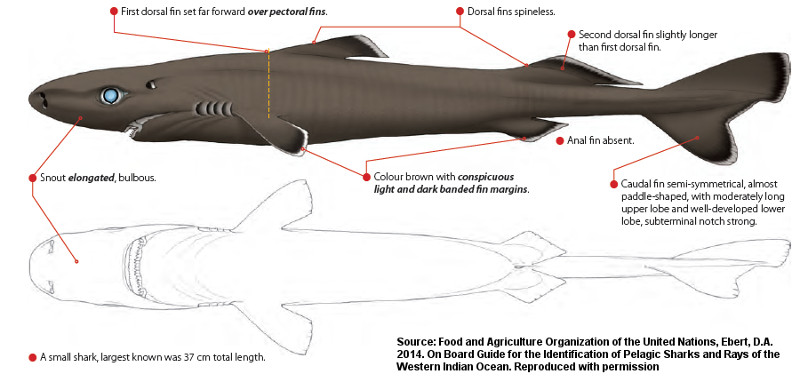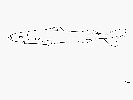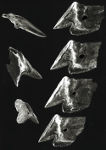Heteroscymnoides marleyi
Fowler, 1934
Longnose pygmy shark
Classification: Elasmobranchii Squaliformes Dalatiidae
Reference of the original description
Descriptions of new fishes obtained 1907 to 1910, chiefly in the Philippine Islands and adjacent seas. Proceedings of the Academy of Natural Sciences of Philadelphia, 85, 233–367
Descriptions of new fishes obtained 1907 to 1910, chiefly in the Philippine Islands and adjacent seas. Proceedings of the Academy of Natural Sciences of Philadelphia, 85, 233–367
Image of the original description
Image in copyright.
Image in copyright.
Description :
Citation: Heteroscymnoides marleyi Fowler, 1934: In: Database of modern sharks, rays and chimaeras, www.shark-references.com, World Wide Web electronic publication, Version 12/2025
Please send your images of "Heteroscymnoides marleyi" to info@shark-references.com

Heteroscymnoides marleyi Fowler, 1934, © FAO, Food and Agriculture Organization of the United Nations, Ebert, D.A. 2014. On Board Guide for the Identification of Pelagic Sharks and Rays of the Western Indian Ocean. Reproduced with permission, illustration by Marc Dando , Wildlife Illustrator

Heteroscymnoides marleyi Fowler, 1934, © FAO, Food and Agriculture Organization of the United Nations, Ebert, D.A. 2014. On Board Guide for the Identification of Pelagic Sharks and Rays of the Western Indian Ocean. Reproduced with permission, illustration by Marc Dando , Wildlife Illustrator
Common names
 Tollo pigmeo trompudo,
Tollo pigmeo trompudo,  Tollo pigmeo troumpudo,
Tollo pigmeo troumpudo,  Squale mignon,
Squale mignon,  Squale mignone,
Squale mignone,  Longnose pygmy shark
Longnose pygmy shark
 Tollo pigmeo trompudo,
Tollo pigmeo trompudo,  Tollo pigmeo troumpudo,
Tollo pigmeo troumpudo,  Squale mignon,
Squale mignon,  Squale mignone,
Squale mignone,  Longnose pygmy shark
Longnose pygmy shark
Short Description
Original Diagnosis after EBERT [22775]: Field Marks: Small size, bulbous elongated snout, no dorsal–fin spines, first dorsal fin far forward, with origin over pectoral–fin bases, second dorsal fin only slightly larger than first, no anal fin, dark brown colour with light–edged fins. Diagnostic Features: Anterior nasal flaps very short, not expanded into barbels. Snout very long, bulbously conical, length almost half head length and about equal to distance from mouth to pectoral–fin origins. Gill openings very small, uniformly wide. Lips thin, not fringed, pleated or suctorial. Teeth strongly different in upper and lower jaws, uppers small, with narrow, acute, erect cusps and no cusplets, not bladelike, lowers much larger, bladelike, interlocked, with a high, moderately broad, semi–erect cusp and distal blade, edges not serrated; tooth rows 22 upper jaw, 23 lower jaw. Both dorsal fins spineless. First dorsal–fin well forward, origin over pectoral–fin bases, insertion far ahead of pelvic–fin origins and much closer to pectoral–fin bases than pelvic fins. Second dorsal fin slightly larger than first but with base about equal to first dorsal–fin base. Origin of second dorsal fin over midbase of pelvic fins. Pectoral fins with short, narrowly rounded free rear tips and inner margins, not expanded and acute or lobate. Caudal fin semi–symmetrical, almost paddle–shaped, with moderately long upper lobe and well–developed lower lobe, subterminal notch strong. No precaudal pits, lateral or midventral keels on caudal peduncle. Dermal denticles flat but with pedicels, with lanceolate, ridged, wedge–shaped, monocuspidate crowns. Cloaca normal, not expanded as a luminous gland. Vertebral counts: total vertebral count 70, precaudal vertebral count 52. Colour: brown with conspicuous light and dark banded fin margins.
Original Diagnosis after EBERT [22775]: Field Marks: Small size, bulbous elongated snout, no dorsal–fin spines, first dorsal fin far forward, with origin over pectoral–fin bases, second dorsal fin only slightly larger than first, no anal fin, dark brown colour with light–edged fins. Diagnostic Features: Anterior nasal flaps very short, not expanded into barbels. Snout very long, bulbously conical, length almost half head length and about equal to distance from mouth to pectoral–fin origins. Gill openings very small, uniformly wide. Lips thin, not fringed, pleated or suctorial. Teeth strongly different in upper and lower jaws, uppers small, with narrow, acute, erect cusps and no cusplets, not bladelike, lowers much larger, bladelike, interlocked, with a high, moderately broad, semi–erect cusp and distal blade, edges not serrated; tooth rows 22 upper jaw, 23 lower jaw. Both dorsal fins spineless. First dorsal–fin well forward, origin over pectoral–fin bases, insertion far ahead of pelvic–fin origins and much closer to pectoral–fin bases than pelvic fins. Second dorsal fin slightly larger than first but with base about equal to first dorsal–fin base. Origin of second dorsal fin over midbase of pelvic fins. Pectoral fins with short, narrowly rounded free rear tips and inner margins, not expanded and acute or lobate. Caudal fin semi–symmetrical, almost paddle–shaped, with moderately long upper lobe and well–developed lower lobe, subterminal notch strong. No precaudal pits, lateral or midventral keels on caudal peduncle. Dermal denticles flat but with pedicels, with lanceolate, ridged, wedge–shaped, monocuspidate crowns. Cloaca normal, not expanded as a luminous gland. Vertebral counts: total vertebral count 70, precaudal vertebral count 52. Colour: brown with conspicuous light and dark banded fin margins.
Distribution
Southeast Atlantic: near Ascension Island. Western Indian Ocean: Durban, Natal, South Africa. Source: www.gbif.org
Southeast Atlantic: near Ascension Island. Western Indian Ocean: Durban, Natal, South Africa. Source: www.gbif.org
Human uses
fisheries: of no interest
fisheries: of no interest
Remarks
shark-references Species-ID=2834;
shark-references Species-ID=2834;



















